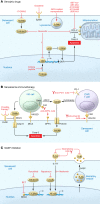Strategies targeting cellular senescence - PubMed (original) (raw)
Review
. 2018 Apr 2;128(4):1247-1254.
doi: 10.1172/JCI95149. Epub 2018 Apr 2.
- PMID: 29608140
- PMCID: PMC5873866
- DOI: 10.1172/JCI95149
Review
Strategies targeting cellular senescence
Yossi Ovadya et al. J Clin Invest. 2018.
Abstract
Cellular senescence is a physiological phenomenon that has both beneficial and detrimental consequences. Senescence limits tumorigenesis and tissue damage throughout the lifetime. However, at the late stages of life, senescent cells increasingly accumulate in tissues and might also contribute to the development of various age-related pathologies. Recent studies have revealed the molecular pathways that preserve the viability of senescent cells and the ones regulating their immune surveillance. These studies provide essential initial insights for the development of novel therapeutic strategies for targeting senescent cells. At the same time they stress the need to understand the limitations of the existing strategies, their efficacy and safety, and the possible deleterious consequences of senescent cell elimination. Here we discuss the existing strategies for targeting senescent cells and upcoming challenges in translating these strategies into safe and efficient therapies. Successful translation of these strategies could have implications for treating a variety of diseases at old age and could potentially reshape our view of health management during aging.
Conflict of interest statement
Conflict of interest: YO and VK are inventors on pending patents in the field (PCT/IL2014/050358, PCT/IL2016/050220, and PCT/IL2016/050702 for VK; and PCT/IL2016/050535 for VK and YO).
Figures
Figure 1. Strategies targeting cellular senescence.
Three principal approaches could be implemented to block deleterious effects of senescent cells. (A) The leading options are strategies that induce apoptosis selectively in senescent cells with the use of senolytic drugs, which block prosurvival pathways. (B) The second type of strategy is to potentiate an immune response against senescent cells in a way that would lead to their clearance from tissues. (C) A third strategy proposes specific blockade of SASP components by targeting of their upstream regulators and effectors. ADCC, antibody-dependent cell-mediated cytotoxicity; DDR, DNA damage response; GOS, galacto-oligosaccharides; ITAM, immunoreceptor tyrosine-based activation motif.
Similar articles
- Targetable mechanisms driving immunoevasion of persistent senescent cells link chemotherapy-resistant cancer to aging.
Muñoz DP, Yannone SM, Daemen A, Sun Y, Vakar-Lopez F, Kawahara M, Freund AM, Rodier F, Wu JD, Desprez PY, Raulet DH, Nelson PS, van 't Veer LJ, Campisi J, Coppé JP. Muñoz DP, et al. JCI Insight. 2019 Jun 11;5(14):e124716. doi: 10.1172/jci.insight.124716. JCI Insight. 2019. PMID: 31184599 Free PMC article. - Emerging Therapeutic Approaches to Target the Dark Side of Senescent Cells: New Hopes to Treat Aging as a Disease and to Delay Age-Related Pathologies.
Khalil R, Diab-Assaf M, Lemaitre JM. Khalil R, et al. Cells. 2023 Mar 16;12(6):915. doi: 10.3390/cells12060915. Cells. 2023. PMID: 36980256 Free PMC article. Review. - The ECM path of senescence in aging: components and modifiers.
Levi N, Papismadov N, Solomonov I, Sagi I, Krizhanovsky V. Levi N, et al. FEBS J. 2020 Jul;287(13):2636-2646. doi: 10.1111/febs.15282. Epub 2020 Mar 20. FEBS J. 2020. PMID: 32145148 Review. - Oncogenic senescence: a multi-functional perspective.
Baker DJ, Alimirah F, van Deursen JM, Campisi J, Hildesheim J. Baker DJ, et al. Oncotarget. 2017 Apr 18;8(16):27661-27672. doi: 10.18632/oncotarget.15742. Oncotarget. 2017. PMID: 28416761 Free PMC article. - Mechanisms and functions of cellular senescence.
Herranz N, Gil J. Herranz N, et al. J Clin Invest. 2018 Apr 2;128(4):1238-1246. doi: 10.1172/JCI95148. Epub 2018 Apr 2. J Clin Invest. 2018. PMID: 29608137 Free PMC article. Review.
Cited by
- Drug Delivery Strategies for Age-Related Diseases.
Yoshihara K, Horiguchi M. Yoshihara K, et al. Int J Mol Sci. 2024 Aug 9;25(16):8693. doi: 10.3390/ijms25168693. Int J Mol Sci. 2024. PMID: 39201377 Free PMC article. Review. - Cardiomyocyte senescence and the potential therapeutic role of senolytics in the heart.
Zhai P, Sadoshima J. Zhai P, et al. J Cardiovasc Aging. 2024 Apr;4(2):18. doi: 10.20517/jca.2024.06. Epub 2024 May 30. J Cardiovasc Aging. 2024. PMID: 39119147 Free PMC article. - Senescent cell-derived vaccines: a new concept towards an immune response against cancer and aging?
Pessoa J, Nóbrega-Pereira S, de Jesus BB. Pessoa J, et al. Aging (Albany NY). 2024 Jun 26;16(12):10657-10665. doi: 10.18632/aging.205975. Epub 2024 Jun 26. Aging (Albany NY). 2024. PMID: 38942604 Free PMC article. Review. - Fibronectin and vitronectin alleviate adipose-derived stem cells senescence during long-term culture through the AKT/MDM2/P53 pathway.
Tragoonlugkana P, Pruksapong C, Ontong P, Kamprom W, Supokawej A. Tragoonlugkana P, et al. Sci Rep. 2024 Jun 20;14(1):14242. doi: 10.1038/s41598-024-65339-z. Sci Rep. 2024. PMID: 38902430 Free PMC article. - Targeting pathological cells with senolytic drugs reduces seizures in neurodevelopmental mTOR-related epilepsy.
Ribierre T, Bacq A, Donneger F, Doladilhe M, Maletic M, Roussel D, Le Roux I, Chassoux F, Devaux B, Adle-Biassette H, Ferrand-Sorbets S, Dorfmüller G, Chipaux M, Baldassari S, Poncer JC, Baulac S. Ribierre T, et al. Nat Neurosci. 2024 Jun;27(6):1125-1136. doi: 10.1038/s41593-024-01634-2. Epub 2024 May 6. Nat Neurosci. 2024. PMID: 38710875 Free PMC article.
References
- World Health Organization. World Report on Ageing And Health. Geneva, Switzerland: World Health Organization; 2015. http://www.who.int/ageing/events/world-report-2015-launch/en/ Accessed February 15, 2018.
- Bloom DE, Boersch-Supan A, McGee P, Seike A. Population aging: facts, challenges, and responses. Program on the Global Demography of Aging. No. 71. Harvard University Website. https://cdn1.sph.harvard.edu/wp-content/uploads/sites/1288/2013/10/PGDA_... Accessed February 15, 2018.
Publication types
MeSH terms
LinkOut - more resources
Full Text Sources
Other Literature Sources
Medical
